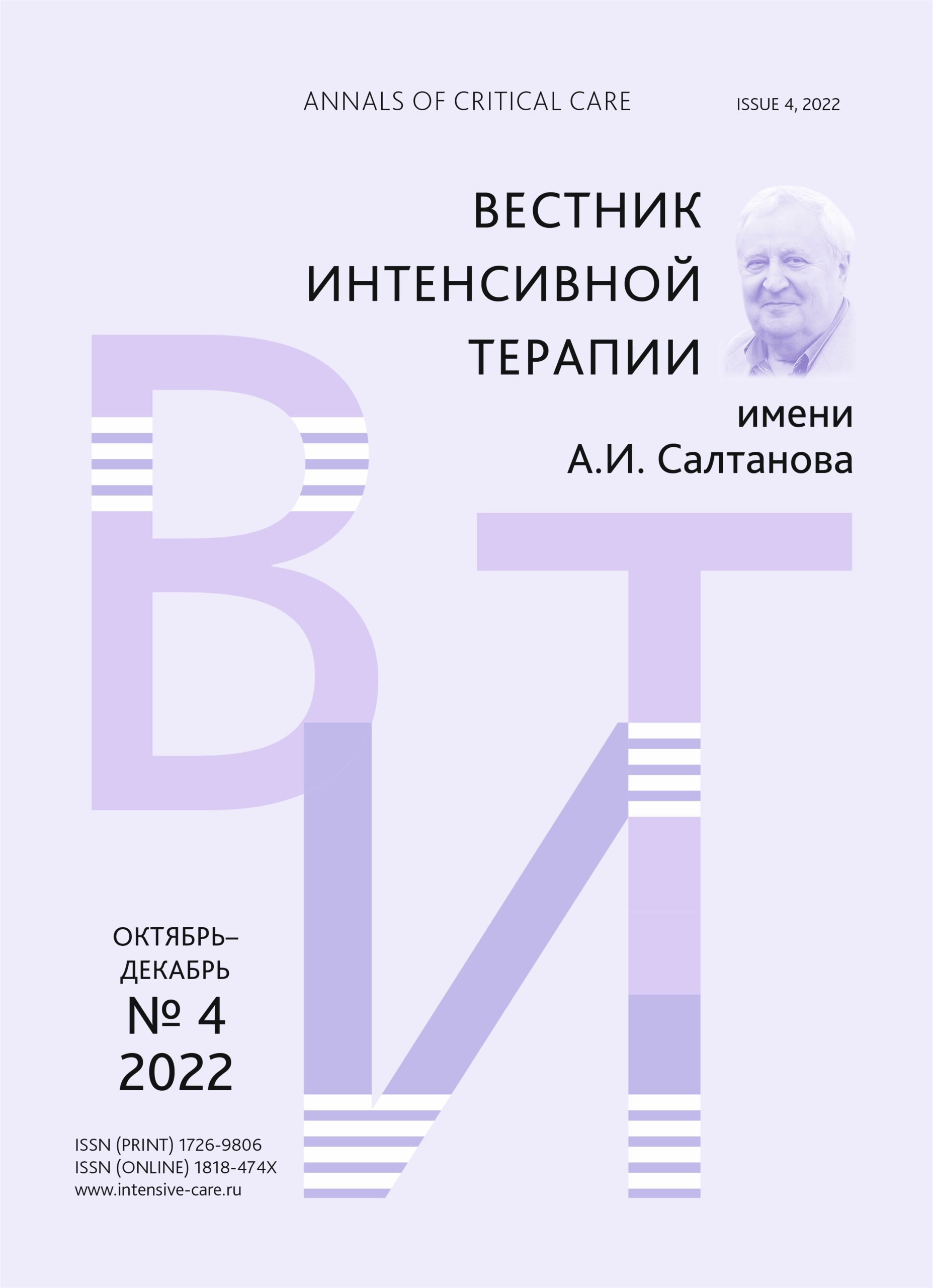Аннотация
АКТУАЛЬНОСТЬ: Аномалии развития аноректальной области являются одними из наиболее распространенных врожденных пороков развития, требующих проведения хирургических вмешательств и сопровождающихся стресс-реакцией в периоперационном периоде. ЦЕЛЬ ИССЛЕДОВАНИЯ: Изучить влияние анестезии на показатели гемодинамики при коррекции аноректальных аномалий у детей. МАТЕРИАЛЫ И МЕТОДЫ: Проспективное одноцентровое рандомизированное исследование. Обследовано 60 детей, всем была выполнена заднесагиттальная аноректопластика по Пенья. Дети были разделены на две группы: группа 1 — комбинированная анестезия (n = 30), группа 2 — сочетанная анестезия (n = 30). Исследование включало пять этапов: I этап — за сутки до операции; II этап — после индукции анестезии; III этап — низведение кишечника; IV этап — пробуждение; V этап — через сутки после операции. Во время исследования оценивались частота сердечных сокращений, систолическое и диастолическое артериальное давление, фракция выброса и ударный объем. РЕЗУЛЬТАТЫ: Выявлено, что на этапе низведения кишечника у детей на фоне сочетанной анестезии отмечено более выраженное уменьшение частоты сердечных сокращений (120 vs 106; р < 0,001). Аналогичные изменения были характерны и для диастолического артериального давления (48 и 42; р < 0,001). Показатели среднего артериального давления также были значительно ниже в группе, где применялась сочетанная анестезия, причем это было статистически значимо как на III, так и на IV этапе (59,3 vs 54,7, р < 0,001; 61,5 vs 57,0, р < 0,001). В группе, где применялась комбинированная анестезия, на этапе пробуждения было отмечено снижение ударного объема, что явилось статистически значимым по сравнению с I–III этапами исследования (р < 0,005). Максимальные показатели фракции выброса отмечены на этапе низведения кишечника на фоне комбинированной анестезии, что явилось статистически значимым по сравнению с другими этапами исследования. ВЫВОДЫ: При использовании сочетанной анестезии на этапе низведения кишечника отмечается статистически значимое снижение частоты сердечных сокращений и системного артериального давления, что, вероятнее всего, обусловлено мощным симпатолитическим эффектом местных анестетиков.
Библиографические ссылки
- Gupta D.K. Anorectal Malformations — Wing spread to Krickenbeck. J Indian Assoc Pediatr Surg. 2005; 10: 75–7.
- Lawal T.A. Overview of Anorectal Malformations in Africa. Front Surg. 2019; 6: 7. DOI: 10.3389/fsurg.2019.00007
- Moore S.W., Sidler D., Hadley G.P. Anorectal malformations in Africa. S Afr J Surg. 2005; 43(4): 174–5.
- Theron A.P., Brisighelli G., Theron A.E., et al. Comparison in the incidence of anorectal malformations between a first- and third-world referral center. Pediatr Surg Int. 2015; 31(8): 759–64. DOI: 10.1007/s00383-015-3740-x
- Smith C.A., Avansino J. Anorectal Malformations. 2021 Aug 12. In: StatPearls [Internet]. Treasure Island (FL): StatPearls Publishing; 2022 Jan.
- Wijers C.H., de Blaauw I., Marcelis C.L., et al. Research perspectives in the etiology of congenital anorectal malformations using data of the International Consortium on Anorectal Malformations: evidence for risk factors across different populations. Pediatr Surg Int. 2010; 26(11): 1093–9. DOI: 10.1007/s00383-010-2688-0
- Mundt E., Bates M.D. Genetics of Hirschsprung disease and anorectal malformations. Semin Pediatr Surg. 2010; 19(2): 107–17. DOI: 10.1053/j.sempedsurg.2009.11.015
- Teerlink C.C., Bernhisel R., Cannon-Albright L.A., Rollins M.D. A genealogical assessment of familial clustering of anorectal malformations. J Hum Genet. 2018; 63(10): 1029–34. DOI: 10.1038/s10038-018-0487-y
- Fuchs M.E., Halleran D.R., Bourgeois T., et al. Correlation of anorectal malformation complexity and associated urologic abnormalities. J Pediatr Surg. 2021; 56(11): 1988–92. DOI: 10.1016/j.jpedsurg.2021.02.051
- Ogundoyin O.O., Olulana D.I., Lawal T.A. Experience with the management of anorectal malformations in Ibadan, Nigeria. Pan Afr Med J. 2021; 38: 214. DOI: 10.11604/pamj.2021.38.214.21690
- Ameh E.A., Seyi-Olajide J.O., Sholadoye T.T. Neonatal surgical care: a review of the burden, progress and challenges in sub-Saharan Africa. Paediatr Int Child Health. 2015; 35(3): 243–51. DOI: 10.1179/2046905515Y.0000000033
- Заболотский Д.В., Корячкин В.А., Ульрих Г.Э. и др. Проект клинических рекомендаций по применению нейроаксиальной анестезии у детей для периоперационной аналгезии. Регионарная анестезия и лечение острой боли. 2017; 4: 279–90. [Zabolotskii D.V., Koryachkin V.A., Ulrikh G.E., et al. Draft of clinical recommendations on the use of neuroaxial anesthesia in children for perioperative analgesia. Regionarnaya аnesteziya i lechenie ostroy boli (Regional Anesthesia and Acute Pain Management, Russian journal). 2017; 11(4): 279–90. DOI: 10.18821/1993-6508-2017-11-4-279-290 (In Russ)]
- Кровообращение и анестезия. Оценка и коррекция системной гемодинамики во время операции и анестезии. Под ред. К.М. Лебединского. СПб., 2015. [Krovoobrashhenie i anestezija. Ocenka i korrekcija sistemnoj gemodinamiki vo vremja operacii i anestezii. Pod red. K.M. Lebedinskogo. SPb., 2015. (In Russ)]
- Сичкарь С.Ю., Афуков И.И. Эпидуральная анестезия у новорожденных и грудных детей с хирургическими заболеваниями. Российский вестник детской хирургии, анестезиологии и реаниматологии. 2015; 2: 47–53. [Sichkar S.Yu., Afukov I.I. Epidural anesthesia in newborns and infnats with surgical diseases. Russian journal of pediatric surgery, anesthesia and intensive care. 2015; 2: 47–53. (In Russ)]
- Александрович Ю.С., Воронцова Н.Ю., Гребенников В.А. и др. Рекомендации по проведению инфузионно-трансфузионной терапии у детей во время хирургических операций. Вестник анестезиологии и реаниматологии. 2018; 2: 68–84. [Aleksandrovich Yu.S., Vorontsova N.Yu., Grebennikov V.А., et al. Recommendations on infusion-transfusion therapy in children undergoing surgery. Messenger of anesthesiology and resuscitation. 2018; 15(2): 68–84. DOI: 21292/2078-5658-2018-15-2-68-84 (In Russ)]
- Гржибовский А.М. Типы данных, проверка распределения и описательная статистика. Экология человека. 2008; 1: 52–8. [Grjibovski A.M. Data types, control of distribution and descriptive statistics. Human ecology. 2008; 1: 52–8. (In Russ)]
- Кузовлев А.Н., Ядгаров М.Я., Берикашвили Л.Б. и др. Выбор метода статистического анализа. Анестезиология и реаниматология. 2021; (3): 88–93. DOI: 17116/anaesthesiology202103188 [Kuzovlev A.N., Yadgarov M.Ya., Berikashvili L.B., et al. Choosing the right statistical test. Russian Journal of Anaesthesiology and Reanimatology. 2021; (3): 88–93. DOI: 10.17116/anaesthesiology202103188 (In Russ)]
- Samantaray D.J., Trehan M., Chowdhry V., Reedy S. Comparison of hemodynamic response and postoperative pain score between general anaesthesia with intravenous analgesia versus general anesthesia with caudal analgesia in pediatric patients undergoing open-heart surgery. Ann Card Anaesth. 2019; 22(1): 35–40. DOI: 10.4103/aca.ACA_215_17
- Mercan A., Ture H., Sayin M.M., et al. Comparison of the effect of sevoflurane and halothane anesthesia on the fall in heart rate as a predictor of successful single shot caudal epidural in children. Saudi Med J. 2009; 30(1): 72–6.
- Yuki K., Matsunami E., Tazawa K., et al. Pediatric Perioperative Stress Responses and Anesthesia. Transl Perioper Pain Med. 2017; 2(1): 1–12.

Это произведение доступно по лицензии Creative Commons «Attribution-NonCommercial-ShareAlike» («Атрибуция — Некоммерческое использование — На тех же условиях») 4.0 Всемирная.
Copyright (c) 2022 ВЕСТНИК ИНТЕНСИВНОЙ ТЕРАПИИ имени А.И. САЛТАНОВА

